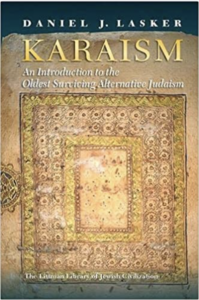I love this book. It is a perfect overview and amazing introduction to Karaite Judaism. Even I – who has been studying Karaite Judaism formally for 20+ years (and informally my entire life) – learned a tremendous amount from this book. After the jump, you can watch my video review of the book, and you can also vote on which book I do a video review of next. I’ll also describe more parts of the book that I absolutely love – and one part that I absolutely disagree with.
Category Archives: Crimea
Turkic, Crimean and Lithuanian Karaite Matzah Recipe
Sometimes it’s easy to forget that Karaites have historically flourished in places outside of Egypt. But the Karaites of Turkey, Crimea, and Lithuania all thrived at one time or another. As pointed out in the comments to the post on Egyptian Karaite matzah recipe, these other communities had a form of matzah called Timbil.
Unfortunately, I don’t have a high resolution image of Timbil, but Avraham Ben-Rahamiël Qanaï, who is a co-author of the Introduction to Karaite Judaism, provided the following:
According to Avraham, this type of Timbil is made with flour and water: “The top is rubbed with oil (and sometimes sprinkled with Nigella seeds) and scored in a criss-cross or diamond pattern before baking.”
Happy cooking and remember to submit your photos for the photo contest to shawn@abluethread.com by April 2, 2013.
How do Karaites Pray? The “Haqdamah”

Source: Magnes Museum; The Karaite Jews- Karaite Service, Foster City, CA by Ira Nowinski (Egypt, Israel, and USA, 1984)
Among the most common requests I receive is to provide readers with the means to learn a traditional Karaite prayer. Indeed, the Karaite community (in addition to having a rich interpretive history) has a rich liturgy. Thus far, I have resisted these requests, because it really isn’t the focus of the blog.
Recently, though, there was a discussion on Mi Yodeya asking how Karaites pray. And after Monday’s post on keeping it real, I thought it was time to do at least one post related to Karaite prayer. It didn’t take me long to determine where to begin: the Haqdamah.
Filed under Crimea, Karaite Jews of America, Karaite Prayers & Melody, Prayer
Karaite Studies: The State of the Field (Part II)
 This is the second (and, for now, final) post related to the Karaite Studies: The State of the Field workshop held in Israel in early 2012.
This is the second (and, for now, final) post related to the Karaite Studies: The State of the Field workshop held in Israel in early 2012.
In this post, we’re picking up where we left off by summarizing and annotating the second half of a question-and-answer session between Rabbi Moshe Firrouz, the Chief Rabbi of the Karaite Council of Sages, and various attendees at the workshop. Based on the number of views, the post on the first half of the question-and-answer session was a hit, and YouTube has a video of the entire session.
A little background is necessary before jumping into this post. A lot questions relate to ritual purity. Karaites generally concern themselves with ritual purity more so than Rabbanites because the traditional Karaite view is that one may not enter a holy place (such as, in the Karaite tradition, the sanctuary of a synagogue) while ritually impure. We’ll discuss this issue in more detail in a later post. Other topics in this post relate to Karaite butcher shops, mikvehs, fertility, and even the permissibility of pets.
Filed under Crimea, Daniel Lasker, Fertility, Free Will, Full Prostration, Head Coverings, Karaite Rabbanite Relations, Marriages, Menstruation, Mikveh, Moetzet Hachamim (Council of Sages), Moshe Firrouz, Mourning, Pets, Prayer, Ritual Purity, Sacrifice, Secular Karaism, What is Karaite Judaism, Women in Karaism



